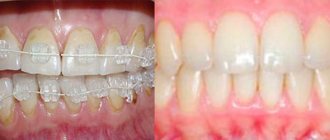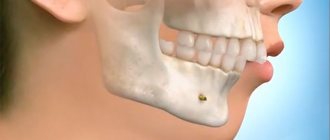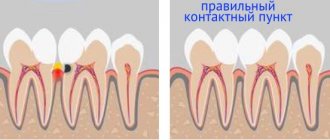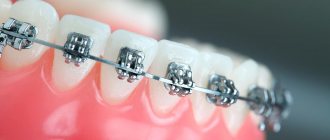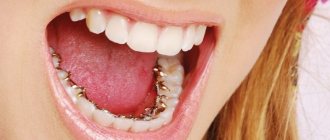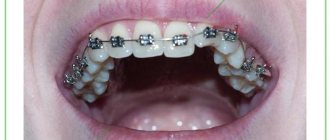From this article you will learn:
- what do clear braces look like?
- reviews on sapphire braces,
- installation cost for 1 or 2 jaws.
Sapphire braces are the most aesthetic option for brace systems in orthodontics, which are characterized by high transparency and maximum invisibility on the teeth (even in comparison with ceramic braces). These braces are made from clear monocrystalline aluminum oxide, often called artificial sapphire. They are almost as strong as metal braces, and at the same time they are much stronger than conventional ceramic braces.
It should be noted that, despite the name, sapphire braces also belong to the ceramic class. The only difference between them is that sapphire ones are made from monocrystalline aluminum oxide, and traditional ceramic ones are made from polycrystalline aluminum oxide. Thanks to this, artificial sapphire braces have high transparency, while traditional ceramic ones have a milky white color and do not have opacity.
Sapphire braces: photo
Options for the best sapphire braces in dentistry –
- “Inspire ICE” braces (USA),
- “Radiance” braces (USA),
- braces “Damon clear” (USA).
For these models of sapphire braces, the price in economy class clinics will average from 160,000 to 200,000 rubles. This cost includes installation of braces on 2 jaws. But in mid-price clinics, the above braces models will cost from 200,000 to 240,000 rubles. However, in a number of clinics you can find more economical options for sapphire braces (for example, “Pure” USA), the price of which will be about 120,000 rubles (for 2 jaws).
But we want to warn you right away. When correcting a bite, the most important thing is the qualifications of the orthodontist, and not the choice of braces as such. There are only a few good orthodontists and, as a rule, the prices for their services are always higher. Therefore, if in one clinic “Inspire ICE” braces cost 180,000 rubles, and in another – 220,000 rubles, then in fact the choice of clinic is not as obvious as it seems. The incompetence and mistakes of the orthodontist can cost much more than this price difference in the future.
Installation of sapphire braces (video) –
In Video 1 you can see the appearance of the Inspire-ICE sapphire ligature brackets (note their stunning transparency). Video 2 shows installation of non-ligature sapphire braces “Damon clear”.
Curse of the family
It was the curse of the Habsburg royal family - a family ugly trait passed down from generation to generation - a protruding, narrow, long jaw that did not allow the lips to close. Men hid the defect under a beard, but women had it much worse... Habsburg lip (there is even such a medical term) is one of the most famous dental anomalies. Its owners, of course, belong not only to the royal dynasty - such a birth defect is not uncommon. There are other malocclusion pathologies, and not only genetics is to blame. Artificial feeding in infancy, too soft food, bad habits, poor environment, excessive stress in athletic sports and many other reasons can provoke malocclusion.
Sapphire products
This design is made from sapphires, but not real ones, but artificial ones. Their action is aimed at correcting defects such as teeth twisted together, sparse dentition or inversion.
| pros | Minuses |
| • inconspicuousness for others; • aesthetic appearance; • diction does not suffer at all when worn; • not subject to contamination; comfortable to wear; • strong fixation, reliability in installation; • caring for them does not require special efforts; • not so susceptible to the appearance of fungi and microorganisms. | • long term wearing of the structure; • the price is not affordable for everyone. Sometimes it reaches 50 thousand rubles; • exposing the jaw to serious chewing loads is strictly contraindicated. The bracket system is usually very fragile; • Sometimes the structure may move slightly. This is due to constant friction between the arc and the securing groove. Such side shifts negatively affect the course of therapeutic treatment. |
Sapphire braces have both pros and cons
beauty and health
Malocclusion is not only an aesthetic problem, it is much more serious. Frequent companions of such an anomaly are caries and periodontal disease. If the upper and lower jaws do not close together, the pressure on the teeth is distributed unevenly, they wear out and wear out much faster. And it’s difficult to chew food normally – a new threat arises: diseases of the gastrointestinal tract. An incorrect bite also negatively affects the quality of speech and negatively affects the breathing process.
But the most dangerous consequence is dysfunction of the temporomandibular joint. It's not pleasant to hear clicking sounds when you chew, yawn, or simply open your mouth. And it’s really bad if you constantly experience pain not only in the jaws, but also in the head, often in the neck, or when there is constant shooting in the ears. Over the years, this can lead to the development of osteoarthritis of the jaw joints - a painful disease that is very difficult to treat.
Ligature or self-ligating: what's the difference?
The effectiveness of the braces system is related not so much to the material as to the mechanism of action. There are two types of metal and ceramic braces.
- In ligature systems, the orthodontic arch is secured using elastic bands. Many dentists consider this type to be more reliable, and the result is predictable. Treatment with ligature braces takes less time, but the patient is forced to come to the orthodontist for correction more often - approximately once every 3-4 weeks. In addition, such a design is more demanding in terms of hygiene, because it is more difficult to clean plaque from under the ligatures.
- The operating principle of self-ligating systems is different. No rubber bands are used here; instead, the plates are equipped with micro-locks that hold the arc in the groove. When installing self-ligating braces, the frequency of visits to the clinic is halved, which is certainly convenient for the patient, but the treatment time - especially in the case of ceramics - will be longer.
When choosing ceramic braces, patients prefer self-ligating structures because they look neater.
It's not just the shoes that are tight
Another very unpleasant thing is crooked and overlapping teeth. This problem also begins in childhood: the jaw bones do not develop enough, and the permanent teeth grow, they do not have enough space, so they have to conquer the neighbor’s territory. This is exactly what happened to my daughter about 20 years ago. Naturally, we quickly caught on, but dentistry at that time was not what it is today. And the mentality of teenagers was different. Today they think that braces are prestigious and cool, but then the daughter was embarrassed to wear the plate and hid it in her pocket at school. In short, nothing could be fixed, but life forced her to be treated by an orthodontist as an adult. At first I was tormented by caries, a little later - endless inflammation of the “pockets” in the gums began, then I had to remove a cyst at the root of the tooth...
Current price of braces
It is impossible to announce the exact cost of braces. Each clinic has its own and will differ slightly, up or down. The final price is influenced by the brand of braces, the qualifications of the doctor, the pricing policy of the clinic, as well as the range of services included in the price. This can be seen in the example of a retainer: its cost is 15-16 thousand rubles, and it can be immediately included in the cost of installing braces, or it may not be included in it - then you will have to pay the required amount. Retainers are installed after the braces are removed - this is the final touch of correction.
A consultation with an orthodontist is usually free, but for diagnostics you will have to pay about 1,600 rubles. It includes drawing up a treatment regimen, taking impressions, calculating TRG, manufacturing work, analysis of a plaster model of the dentition, and an orthopantomogram.
Orthopantomogram
Interesting ! A monthly trip for correction will cost you approximately 2,500 thousand rubles.
Forward-backward, right-left
Today it is quite possible to get rid of such problems. To correct the bite and straighten the dentition, special orthodontic devices of two types are used: removable (the so-called plates) and non-removable (various types of braces).
The huge advantage of braces is that, by exerting a mechanical effect on the teeth, they help to “move” them as required: forward, backward, with rotation along the axis, which allows you to achieve an ideal result. However, it is not possible to increase jaw size with braces. So, if the teeth do not have enough space for their normal position, sometimes it is necessary to remove a closely spaced adjacent tooth and then move the adjacent teeth to build an even row of teeth.
Typically, a set of braces consists of twenty pieces, ten of which are glued to the upper teeth, and the rest to the lower teeth. Any brace system is selected by an orthodontist only individually, depending on the condition of the patient’s teeth.
Differences between sapphire and ceramic braces
Single crystal sapphires are grown and polished at very high temperatures, which helps create a strong, beautiful lock that is almost invisible on the teeth. Ceramic products have noticeable aesthetic qualities, but differ in a number of properties:
- The color scheme does not always allow you to choose a perfectly similar shade of the patient’s tooth enamel.
- Ceramic braces make the dentist's work somewhat more difficult if crooked teeth or malocclusion is a serious anomaly.
- Ceramic braces make it more difficult to control the correct position of the tooth and the entire system as a whole.
- The opaque polycrystalline structure of ceramics can deteriorate as a result of improper handling.
Sculptor in a white coat
Any treatment by an orthodontist begins with a complex diagnosis.
Step one is an orthopantomogram. This is a panoramic, that is, an overview photograph of all the teeth of both jaws. The doctor needs it to assess the condition of the bone tissue, identify foci of inflammation, assess the parallelism of the roots of the teeth - in general, in order to get answers to all questions and draw up a treatment plan.
Step two – dental impressions and computer modeling. Having made impressions of the teeth, the doctor sends them to the laboratory, where plaster models are made. Then they are scanned, and the orthodontist, like a sculptor, virtually models them on a computer, studying the morphology and function of the facial muscles. And only after that the optimal design option is selected.
Installation process and technology
All types of braces are installed using similar technology:
- During the initial examination, the dentist determines the need to install structures and carefully examines the condition of the oral cavity. If necessary, the dentist treats carious teeth and inflamed gums;
- the doctor carries out the necessary tests and measurements;
- installing braces does not take much time (up to half an hour), first a special adhesive is applied, the products are attached, and dried under an ultraviolet lamp;
- The remaining glue is removed, and the patient is given detailed instructions on how to care for braces and the intervals between visits to the dentist.
Incognito and sapphires
It's a good idea to know a few more things about braces. Because they are different, what exactly to choose depends not only on your desire, but also on your wallet.
The most affordable option is metal braces, which are made from medical-grade stainless steel. Their advantage is a weaker friction force between the bracket and the power arch, which contributes to faster tooth movement. The downside is that they are too conspicuous.
Ceramic braces are less noticeable, while sapphire braces are completely transparent and practically merge with the teeth. But they will also cost incomparably more.
Do you want others not to even know that you wear an orthodontic device? No problem! You can install lingual systems, they are also called “incognito”: such braces are glued to the inner surface of the teeth and are completely invisible. However, it takes longer and more difficult to get used to them than to “external” ones. And one more significant “but” - they are about four times more expensive than traditional ones.
The best manufacturers of sapphire braces
There are several reliable manufacturers of high-quality braces systems that use synthetic sapphire crystals. First in the ranking of the best is Radiance (USA). The products are the perfect way to enhance your appearance with a fashion accessory thanks to the shiny finish that shimmers in the light. Radiance sapphire braces are recognized as the most transparent and aesthetic.
Inspire ice from Ormco has increased resistance to stress, which allows you to practically limit the consumption of solid foods. Sapphire clasps look especially attractive when paired with a light-colored arch that is not easily stained. The period of getting used to Inspire Ice is minimal, the design does not cause discomfort, but is not used for severe malocclusions.
Damon Clear is a popular clear model from Ormco, an American orthodontic products company. The braces do not interfere with speaking, are completely transparent, and have no ligatures.
Pure is an invention of the American brand “Ortho Technology”, which has been producing medical equipment for more than 20 years. The product has high aesthetic and quality characteristics, representing an expensive decoration for the treatment of simple types of dental curvature.
What and when?
Braces can be used at any age, but not earlier than from 11–13 years. It is important that not only the process of changing teeth ends, but also that their enamel matures. After all, braces are placed on each tooth separately. And, if you rush, you can ruin the enamel: teeth unprotected by it quickly become victims of caries.
In recent years, older people are increasingly turning to orthodontists: with age, many people need dental prosthetics, and with an incorrect bite, it is not always possible.
Before installing a brace system, of course, dental treatment is carried out, and the doctor must also remove tartar.
Typically, the braces are worn for one and a half to two years, with visits to the orthodontist once a month for regular adjustments to the structure. When the “course of treatment” is over, the doctor removes the braces, polishes the teeth and coats them with a protective compound (for example, fluoride) to prevent caries. But this is not the end yet. For about six months to a year you will need to wear mouth guards at night - special plates that secure the effect.
5 useful tips
1. When wearing braces, pieces of food can get stuck between the teeth and in the structure itself. To prevent bacteria from accumulating in your mouth, brush your teeth immediately after you eat something, even if you only drink a glass of juice. 2. Use a special brush with V-shaped bristles to clean your braces, and use cone-shaped brushes to clean the outer surface of your teeth. 3. Don't drink too hot tea or eat ice cream - your braces may come off. The doctor will be able to glue metal ones, but ceramic or sapphire ones will most likely have to be replaced with new ones. 4. Cut hard fruits - apples, pears, etc. - into small pieces: otherwise, when biting, the design of the braces may be damaged. 5. Limit yourself to flour, sweets, potatoes, you will have to give up energy drinks - this can provoke the development of caries, and treating it while you wear braces is problematic.
Indications and contraindications for use
The indication for installation is the presence of anomalies in the dentition. The correction will take place at the age when the bite is already formed. It is possible to correct both single defects and to correct facial aesthetics. Braces are used when you need to prepare your mouth for prosthetics.
The following conditions are contraindications for installing braces:
- dental caries, other dental problems,
- identification of an allergic reaction to materials that are planned to be used,
- the presence of a large number of fillings, artificial crowns,
- somatic diseases in severe form,
- poor hygiene,
- the presence of stains, chips, cracks on the enamel,
- mental illnesses.
Pregnancy and breastfeeding are not a direct contraindication to installing braces, but it is advisable to engage in treatment later. The orthopedic dentist will tell you about other indications and contraindications.
